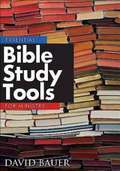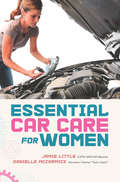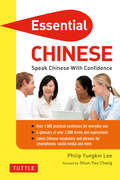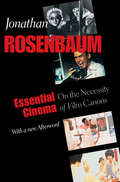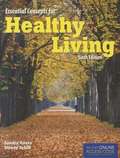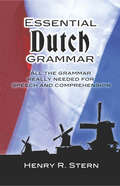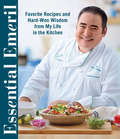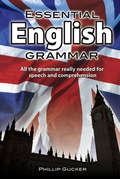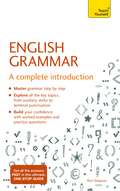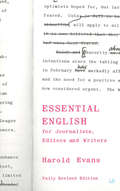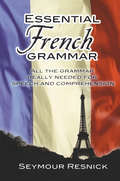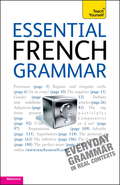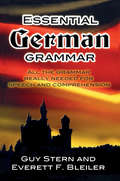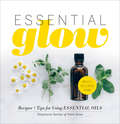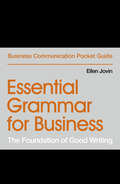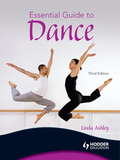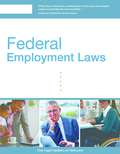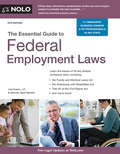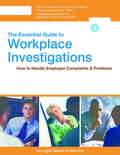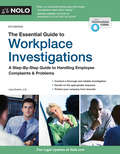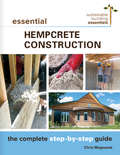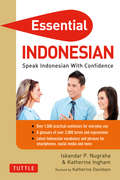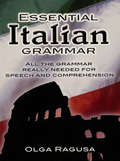- Table View
- List View
Essential Bible Study Tools for Ministry
by David R. BauerThis up-to-date, highly selective bibliography is designed to acquaint students and ministers with major works, significant publishers and prominent scholars in biblical studies. It is the perfect guide for beginning a research project or building a ministerial library. References are included based on the following considerations: (1) usefulness for the theological interpretation of the Bible within the context of the faith of the church; (2) significance in the history of interpretation; and (3) representation of evangelical and especially evangelical Wesleyan scholarship.
Essential Car Care for Women
by Jamie Little Danielle Mccormick"Despite the many advances women have made since the internal combustion engine was invented, there is still one widely held belief that won't seem to go away: that when it comes to cars, women should just leave it to the men. In Essential Car Care for Women, ESPN NASCAR pit reporter Jamie Little and Discovery Channel "Turbo Expert" Danielle McCormick team up to dispel this myth once and for all--and to offer the indispensable, hard-won advice women need to buy, sell, and care for their cars with confidence. With this handy guide, women will learn how to save themselves money by performing basic--but essential--maintenance tasks on their own. Little and McCormick explain what an alternator, regulator, distributor, and timing belt are; how to change a tire, recharge a flat battery, check the oil, and assess tire pressure; what to do when a car breaks down or when an accident occurs; how to buy a car without being taken advantage of; and more. Straightforward and easy to follow--and including simple step-by-step diagrams and pictures to help along the way--Essential Car Care for Women is the ultimate handbook to everything a woman should know about her set of wheels. "--
Essential Chinese
by Philip Yungkin Lee Shun-Yao ChangA concise Mandarin Chinese phrase book and guide to Chinese language, Essential Chinese contains basic vocabulary necessary for communicating in Mandarin Chinese.Mandarin Chinese actually has simpler grammar than English and there are no conjugations-meaning anyone can learn a few important phrases in no time.Essential Chinese is a great first introduction and beginner guide to the language of China and Taiwan. Perfect for business people or tourist traveling to China or for students who want to supplement their learning (and get an A in Mandarin class!), this book's easy indexing feature allows it to act as an Chinese phrasebook or as a Mandarin to English Dictionary / English to Mandarin Dictionary. A clever "point to" feature allows you to simply point to a phrase translated in Chinese without the need to say a single word or read a single character. You will soon find yourself turning to Essential Chinese again and again when visiting and working or interacting with Chinese speakersIn this book you will find:Over 1500 practical sentences for everyday useA glossary of over 200 terms and expressionsTerms and phrases covering essential aspects of traveling and living in China
Essential Cinema: On the Necessity of Film Canons
by Jonathan RosenbaumIn his astute and deeply informed film reviews and essays, Jonathan Rosenbaum regularly provides new and brilliant insights into the cinema as art, entertainment, and commerce. Guided by a personal canon of great films, Rosenbaum sees, in the ongoing hostility toward the idea of a canon shared by many within the field of film studies, a missed opportunity both to shape the discussion about cinema and to help inform and guide casual and serious filmgoers alike.In Essential Cinema, Rosenbaum forcefully argues that canons of great films are more necessary than ever, given that film culture today is dominated by advertising executives, sixty-second film reviewers, and other players in the Hollywood publicity machine who champion mediocre films at the expense of genuinely imaginative and challenging works. He proposes specific definitions of excellence in film art through the creation a personal canon of both well-known and obscure movies from around the world and suggests ways in which other canons might be similarly constructed.Essential Cinema offers in-depth assessments of an astonishing range of films: established classics such as Rear Window, M, and Greed; ambitious but flawed works like The Thin Red Line and Breaking the Waves; eccentric masterpieces from around the world, including Irma Vep and Archangel; and recent films that have bitterly divided critics and viewers, among them Eyes Wide Shut and A.I. He also explores the careers of such diverse filmmakers as Robert Altman, Raúl Ruiz, Frank Tashlin, Elaine May, Sam Fuller, Terrence Davies, Edward Yang, Hou Hsiao-hsien, and Orson Welles. In conclusion, Rosenbaum offers his own film canon of 1,000 key works from the beginning of cinema to the present day. A cogent and provocative argument about the art of film, Essential Cinema is also a fiercely independent reference book of must-see movies for film lovers everywhere.
Essential Concepts for Healthy Living, Sixth Edition
by Sandra Alters Wendy SchiffThoroughly revised and updated, Essential Concepts for Healthy Living, Sixth Edition provides students with a clear and concise introduction to the latest scientific and medical research in personal health. With its unique focus on critical thinking and analysis of health-related behaviors and attitudes, this text enhances students’ understanding of their own health needs and presents the scientific background necessary for students to think critically about the reliability of health-related information they encounter in the media. New to the Sixth Edition Updated Design - interior layout has been upgraded and modernized Includes Healthy People 2020 and MyPlate New sections added - Transgender, Anti-Drug Vaccines, Alcohol-related injury deaths in college students, Electronic cigarettes, or e-cigarettes, Celiac Disease, Consumer Health: CAM Products and Colds, and more
Essential Dutch Grammar (Dover Language Guides Essential Grammar)
by Henry R. SternThis is the first Dutch grammar specifically designed for the adult with limited learning time whose objective is broader, more fluent everyday communication. Avoiding archaic, highly literary and seldom-used forms, this grammar helps those with some knowledge of Dutch use phrases and vocabulary more effectively. For the beginner, it provides all the grammar really needed for speech and comprehension.:Based on the premise that systematic study of grammar is a shortcut to language learning, Essential Dutch Grammar helps you acquire fluency by emphasizing the strong similarities between English and Dutch, and by concentrating on essentials: spelling, word order, articles and nouns, adjectives, adverbs, pronouns, verbs, conjunctions and prepositions--all illustrated by easy-to-understand examples.While explaining how to avoid complicated sentence constructions, tell time and use idioms, the book provides dozens of useful expressions, four detailed appendices on verbs, and a handy glossary of grammatical terms. Whether you're just beginning the study of Dutch or need a handy refresher course, Essential Dutch Grammar offers a modern, streamlined approach that will enable you to master Dutch in the shortest possible time.
Essential Emeril: Favorite Recipes and Hard-Won Wisdom From My Life in the Kitchen
by Emeril Lagasse"Thinking back on all of the wonderful people I have learned from and the dishes I have made over the years, I knew that I had to get them all down in one place. This book is it."- Emeril LagasseIn his most personal cookbook yet, legendary chef Emeril Lagasse presents his favorite recipes, best-kept cooking secrets, and behind-the-scenes stories from his life in the kitchen.Discover more than 130 iconic dishes - from Praline-Cayenne Bacon and Lemon-Garlic Crusted Cauliflower to Roasted Portuguese Pork Loin With Homemade Pimenta Moida and Emeril's famous Banana Cream Pie - each tested and perfected for today's home cook. More than just a recipe collection, Essential Emeril is a resource you'll turn back to again and again, packed with valuable tips, lessons on technique, and expert advice on everything from stocking your pantry to creating the perfect cheese board. Emeril remains at your elbow throughout, offering step-by-step photo tutorials to ensure flawless, flavorful results.Anecdotes reveal the inspiration behind each recipe, with cameos from A-list names including Mario Batali, Roy Choi, and Nobu Matsuhira, alongside memories of family, friends, and early influences such as Julia Child and Charlie Trotter.Gorgeously photographed and imbued with his signature warmth, Essential Emeril is an intimate portrait of the original top chef.
Essential English Grammar
by Philip GuckerThis English grammar has been specially designed for readers with limited learning time, who wish to gain command of all the important points of grammar needed for everyday speech and comprehension, yet who do not wish to be unnecessarily burdened with archaic, highly literary, or seldom used forms. Summarizing all the major constructions, principles, and basic terminology, this book will provide readers with a firm foundation in essential English grammar.The text proceeds in easy, natural steps, beginning with simple sentence structure and advancing logically to more difficult constructions. More than 600 practice exercises and solutions make this an excellent home-study text. Organized with clarity and emphasizing explanation rather than rote memorization, this selective grammar can be used effectively as a course supplement, as an introduction for beginners, or as a reference for students and teachers.
Essential English Grammar: A Complete Introduction
by Ron Simpson Brigitte EdelstonEssential English Grammar is packed with easy-to-follow explanations and summaries, practical tips on how to avoid common grammar mistakes, interesting facts about the historical and regional use of English and a special section on punctuation. This clear, straightforward guide to modern English grammar will help you to improve your knowledge of the language and perfect your grammar.NOT GOT MUCH TIME?One, five and ten-minute introductions to key principles to get you started.AUTHOR INSIGHTSLots of instant help with common problems and quick tips for success, based on the author's many years of experience.TEST YOURSELFTests in the book and online to keep track of your progress.EXTEND YOUR KNOWLEDGEExtra online articles at www.teachyourself.com to give you a richer understanding of English grammar.FIVE THINGS TO REMEMBERQuick refreshers to help you remember the key facts.TRY THISInnovative exercises illustrate what you've learnt and how to use it.
Essential English Grammar: A Complete Introduction (TY English Reference)
by Ron Simpson Brigitte EdelstonEssential English Grammar is packed with easy-to-follow explanations and summaries, practical tips on how to avoid common grammar mistakes, interesting facts about the historical and regional use of English and a special section on punctuation. This clear, straightforward guide to modern English grammar will help you to improve your knowledge of the language and perfect your grammar.NOT GOT MUCH TIME?One, five and ten-minute introductions to key principles to get you started.AUTHOR INSIGHTSLots of instant help with common problems and quick tips for success, based on the author's many years of experience.TEST YOURSELFTests in the book and online to keep track of your progress.EXTEND YOUR KNOWLEDGEExtra online articles at www.teachyourself.com to give you a richer understanding of English grammar.FIVE THINGS TO REMEMBERQuick refreshers to help you remember the key facts.TRY THISInnovative exercises illustrate what you've learnt and how to use it.
Essential English for Journalists, Editors and Writers
by Harold Evans Crawford GillanEssential English is an indispensable guide to the use of words as tools of communication. It is written primarily for journalists, yet its lessons are of immense value to all who face the problem of giving information, whether to the general public or within business, professional or social organisations.FULLY REVISED AND UPDATED BY CRAWFORD GILLANRECOMMENDED BY THE SOCIETY OF EDITORS
Essential French Grammar
by Seymour ResnickThis is the first French grammar designed specifically for adults with limited learning time who wish to acquire a knowledge of simple, everyday spoken French, and who have no need of all the archaic, highly literary, and seldom used forms that must be covered in a conventional grammar. It is not a simplified study, but a selective grammar that points out many time-saving short cuts.Constantly drawing comparisons with English construction, it covers all of the important points in French grammar (verb forms and tenses, parts of speech, negative sentences, possessives, partitive construction, etc.) fully and logically, and with refreshing clarity. It was created for those who prefer the phrase approach, and all grammatical points are illustrated with phrases and sentences that you can incorporate directly into your working vocabulary. Many of the discussions include a list of common expressions that use the rule under study.In addition to the grammar text itself, there are several unusual features of great value to anyone who wants to build a French vocabulary: a section on common word-endings and their French equivalents, for example, and a 50-page lit of French-English cognates.This grammar does not assume any previous knowledge either of grammatical terms or of French grammar. English grammatical terms are explained in a separate section and all discussion begins with essentials and works up from there. Use it as an introduction to grammar, for independent class courses, with phrase courses, as a refresher, or for beginning self-study.
Essential French Grammar: Teach Yourself
by Robin Adamson Brigitte EdelstonEssential French Grammar will help you get more out of your study of French. Essential French Grammar is an up-to-date introduction to French grammar. You don't need to know a lot about grammar before you start. Everything is explained simply and there are lots of examples to illustrate each point. Unlike more traditional grammars, Essential French Grammar is structured so that you can look up language forms according to what you want to say, even if you don't know the grammatical term for them. If you already know some grammar, then you can use the 'reference grammar' section at the back of the book to look up the points you need.The course consists of 18 units illustrating the various uses to which the language can be put, for example, giving instructions or talking about the recent past. The more traditional reference grammar deals with grammatical structures, such as the imperative or the perfect tense. All grammatical terms are explained in the glossary at the back of the book. Each unit contains exercises for you to practice what you have learnt and there is a key at the back of the book for you to check your answers. The new page design in this edition means that the book is even easier to use and the main headings are in English so that you can find your way around the book quickly. This edition contains a 'taking it further' section which will direct you to further sources of real French. Essential French Grammar will help you to understand and manipulate French grammar with confidence because:- you need no prior knowledge of grammatical terminology to use it;- the approach is accessible and supportive;- the examples are clear and in context;- exercises help you practise every point.Now in a brand new edition with new, easy-to-follow page design and interactive on-line features:NOT GOT MUCH TIME?One, five and ten-minute introductions to key principles to get you started.AUTHOR INSIGHTSLots of instant help with common problems and quick tips for success, based on the author's many years of experience.USEFUL VOCABULARYEasy to find and learn, to build a solid foundation for speaking.END-OF-UNIT SUMMARIES AND ONLINE TESTSSummaries and tests to help you keep track of your progress.EXTEND YOUR KNOWLEDGEExtra online articles at: www.teachyourself.com to give you a richer understanding of the culture and history of French.
Essential German Grammar
by Guy Stern E. F. BleilerThis is the first German grammar which has been specifically designed for the adult with limited learning time who wishes to be able to express himself with reasonable accuracy, yet does not wish to be burdened with archaic, highly literary, or seldom used forms. It covers the most important points of German grammar in the clearest possible manner, stressing regularities rather than irregularities and concentrating upon the constructions and expression-modes that you would be most likely to use. It has been created for readers who prefer the phrase-approach, and all grammatical points are illustrated with phrases and sentences that you can use immediately. Hints are included throughout the book on replacing difficult constructions with easier ones.The basic presentation technique has been able to evoke the strong similarities between English and German, rather than the differences. As a result it is easier for you to understand and imitate German speech patterns. Among other unusual features of this grammar are: a means of avoiding most of the intricacies of noun declension; a logical, easily followed presentation of verbs compounded with separable or inseparable prefixes; a statement on word order that enables you to see English parallels; and an immediately useful presentation of basic German grammar.This grammar does not assume knowledge of grammatical terms (a supplement explains English grammatical terms) or of German grammar.
Essential Glow: Recipes & Tips for Using Essential Oils
by Stephanie GerberDiscover how essential oils can boost your beauty, home, and wellness with over 200 easy recipes and projects from the author of Hello Glow. Lavender, chamomile, tea tree, rose, and sandalwood—invite the aromatic and healing powers of your favorite herbs and botanicals into your life with this beautiful guide. You&’ll discover recipes, quick tips, and DIY projects to boost your beauty, home, and general wellness with your favorite essential oils, plus a diagnostic tool that helps you treat common ailments with the right essential oils. We&’ve all heard that essential oils are good for us—the aromas and chemicals in these special distilled herbal treatments can soothe the senses, kick-start a sluggish day, or even help restore health or repair troubled skin. There are a whole host of ways to use them—from decadent massage candles to hardworking laundry softeners, from relieving bug-bite balm to skin-clearing concoctions. Essential Glow is packed with everything the aromatherapy DIY-er needs: 200+ recipes and projects with simple step-by-step instructions, targeted aromatherapy blends, a pantry primer, and much more.Featured essential oils include:Soothe: Lavender, Roman Chamomile, Geranium, Rose, Clary Sage, Jasmine, Ylang Ylang, SandalwoodUplift: Peppermint, Sweet Orange, Cinnamon, Atlas Cedarwood, Lemongrass, Juniper Berry, RosemaryRestore: Oregano, Frankincense, Ginger, Tea Tree, Lemon, Eucalyptus
Essential Grammar for Business: The Foundation of Good Writing (Business Communication Pocket Guides)
by Ellen JovinReliable, authoritative, and designed to ease grammar anxiety!Words are the currency of every business transaction. They persuade, inspire, educate and clarify. Essential Grammar for Business offers guidance to professionals perplexed by proper comma placement, dangling modifiers or the difference between who and whom. With a better understanding of the building blocks, readers will be better equipped to focus on the other ingredients of good business writing such as content, clarity and style. This book is fun, fast-paced, and easy to use.
Essential Guide to Dance, 3rd edition
by Linda AshleyThis third edition of the bestselling text ESSENTIAL GUIDE TO DANCE is thoroughly updated to meet the new AS/A2 specifications and relevant Applied A-levels, BTEC and other Dance qualifications. Now in full colour, highly illustrated, and packed with tasks and activities to cover all aspects of current courses, this text will appeal to both teachers and students.Students are brought right up to date with clear explanations of choreography, performance and appreciation of Dance, as well as recent examples of new set works and choreographers. With further video and photo interactive analysis tasks, the addition of short revision tests and updated professional examples alongside many contemporary photographs, ESSENTIAL GUIDE TO DANCE Third Edition provides students with comprehensive support and guidance.With its emphasis on the practical aspects of Dance and its interactive features that encourage effective learning, ESSENTIAL GUIDE TO DANCE Third Edition will be essential for all students of Dance and their teachers.Linda Ashley has extensive experience as a writer, choreographer, performer and teacher of Dance. Linda is currently Dance Research Leader at AUT University, New Zealand, Linda has written several Dance titles, published in the UK and New Zealand, including the two previous bestselling editions of ESSENTIAL GUIDE TO DANCE, both published by Hodder.
Essential Guide to Federal Employment Laws
by Lisa Guerin Sachi BarreiroNavigating an employer's obligations under federal employments laws can be confusing and overwhelming. The FMLA, ADA, FLSA, NLRA--it can be difficult just to keep the acronyms straight! With the The Essential Guide to Federal Employment Laws, you'll learn the ins and outs of the 20 major federal employment laws, including: which businesses must comply with each law what each law allows and prohibits which federal agency enforces each law and practical tips to remain within the scope of the law Each chapter is dedicated to explaining and demystifying one federal employment law, including: the Americans with Disabilities Act the Family and Medical Leave Act the Fair Labor Standards Act the National Labor Relations Act the Equal Pay Act and much more Stay ahead of the game and protect your company and yourself--get The Essential Guide to Federal Employment Laws.
Essential Guide to Federal Employment Laws, The
by Lisa Guerin Sachi BarreiroQuick answers to questions about 20 Key Employment Laws With the The Essential Guide to Federal Employment Laws, you’ll learn the ins and outs of the most important national employment laws, including: which businesses must comply with each law what each law allows and prohibits which federal agency enforces each law and practical tips to avoid violations of the law Each chapter is dedicated to explaining and demystifying one federal employment law, including the: Americans with Disabilities Act Family and Medical Leave Act Fair Labor Standards Act Immigration Reform and Control Act National Labor Relations Act Pregnancy Discrimination Act Equal Pay Act and much more. Stay ahead of the game and protect your company and yourself -- get The Essential Guide to Federal Employment Laws.
Essential Guide to Workplace Investigations, The: A Step-By-Step Guide to Handling Employee Complaints & Problems
by Lisa GuerinThe Essential Guide to Workplace Investigations will help any manager, supervisor, or Human Resources professional sort out workplace problems, quickly and effectively. Use this affordable, step-by-step guide to investigate, document, and resolve every kind of workplace problem, from discrimination and harassment to employee theft and workplace violence. Get the facts on: deciding whether to investigate choosing an investigator interviewing and gathering evidence evaluating the evidence documenting the investigation taking action and following up This thorough guide provides all of the forms, sample policies, checklists, and sample documentation that employers need to conduct a successful investigation that will stand up in court. This edition also incorporates the latest legal developments in employment law, including updated 50-state charts on common workplace issues, Supreme Court decisions on discrimination and harassment, and more. Plus, you'll be able to download forms and listen to sample interviews and scenarios online.
Essential Guide to Workplace Investigations, The: A Step-By-Step Guide to Handling Employee Complaints & Problems
by Lisa GuerinThe Essential Guide to Workplace Investigations will help any manager, supervisor, or Human Resources professional sort out workplace problems, quickly and effectively. Use this affordable, step-by-step guide to investigate, document, and resolve every kind of workplace problem, from discrimination and harassment to employee theft and workplace violence. Get the facts on: deciding whether to investigate choosing an investigator interviewing and gathering evidence evaluating the evidence documenting the investigation taking action and following up This thorough guide provides the forms, sample policies, checklists, and sample documentation that employers need to conduct a successful investigation that will stand up in court. This edition also incorporates the latest legal developments in employment law, including updated 50-state charts on common workplace issues, Supreme Court decisions on discrimination and harassment, and more. Plus, you’ll be able to download forms online.
Essential Hempcrete Construction: The Complete Step-by-Step Guide
by Chris MagwoodHempcrete is a versatile, energy-efficient natural insulation material, useful for walls, roofs, and floors. Made from the inner stem of the hemp plant mixed with a lime-based binder, it is a very strong, lightweight and breathable alternative to manufactured insulations. Essential Hempcrete Construction is a fully-illustrated practical guide to this affordable, renewable method, from procurement to finishing.This indispensable manual is packed with all the information you need to determine whether hempcrete is the right choice for your project. It covers: Material specifications, testing and building code references and climate data Detail drawings for design reference Tool lists, and complete step-by-step instructions for mixing and placing hempcrete Finishing and maintenance techniques Budgeting and labor estimates Additional resourcesEssential Hempcrete Construction is part of New Society's Sustainable Building Essentials Series. Written by the world's leading sustainable builders, designers and engineers, these succinct, user-friendly handbooks are indispensable tools for any project where accurate and reliable information are key to success. Get the Essentials!Chris Magwood is a sustainable builder and designer specializing in green and natural building techniques, the co-founder and co-director of the Endeavour Centre, and the author of several books on sustainable building including Making Better Buildings, More Straw Bale Building, and Straw Bale Details.
Essential Indonesian
by Katherine Davidsen Iskandar Nugraha Katherine InghamA concise Indonesian phrase book and guide to Indonesian language, Essential Indonesian contains basic Indonesian vocabulary and grammar necessary for communicating in Indonesian.Part of Tuttle Publishing's Essential Phrasebooks Series, Essential Indonesian is a great first introduction and phrasebook for the language of Indonesia. Perfect for business people or tourist traveling to Indonesia or for students who want to supplement their learning (and get an A in Indonesian!), this book's easy indexing feature allows it to act as an Indonesian phrasebook or as an Indonesian to English Dictionary / English to Indonesian Dictionary. A clever "point to" feature allows you to simply point to a phrase translated in Indonesian without the need to say a single word. You will soon find yourself turning to Essential Indonesian again and again when visiting Indonesia and working or interacting with IndonesiansIn this book you will find:Over 1500 practical sentences for everyday useA glossary of over 200 terms and expressionsTerms and phrases covering essential aspects of traveling and living in IndonesiaLatest Indonesian vocabulary and phrases for smartphones, social media and more
Essential Indonesian
by Katherine Davidsen Iskandar Nugraha Katherine InghamA concise Indonesian phrase book and guide to Indonesian language, Essential Indonesian contains basic Indonesian vocabulary and grammar necessary for communicating in Indonesian.Part of Tuttle Publishing's Essential Phrasebooks Series, Essential Indonesian is a great first introduction and phrasebook for the language of Indonesia. Perfect for business people or tourist traveling to Indonesia or for students who want to supplement their learning (and get an A in Indonesian!), this book's easy indexing feature allows it to act as an Indonesian phrasebook or as an Indonesian to English Dictionary / English to Indonesian Dictionary. A clever "point to" feature allows you to simply point to a phrase translated in Indonesian without the need to say a single word. You will soon find yourself turning to Essential Indonesian again and again when visiting Indonesia and working or interacting with IndonesiansIn this book you will find:Over 1500 practical sentences for everyday useA glossary of over 200 terms and expressionsTerms and phrases covering essential aspects of traveling and living in IndonesiaLatest Indonesian vocabulary and phrases for smartphones, social media and more
Essential Italian Grammar: Essential Grammar (Dover Language Guides Essential Grammar)
by Olga RagusaIn this very useful manual, Dr. Ragusa has presented all the Italian really needed in everyday life and contemporary situations, without devoting space to the intricacies of literary, archaic, and poetic forms that you are not likely to need.It is remarkable how readily Italian grammar lends itself to this form of essential grammar, for within this book Miss Ragusa has presented her material with such clarity that you will probably remember most of what you have read after a single reading. Among the unusual features of this presentation are an extremely clear statement of the complex pronoun situation, an easily followed analysis of the various verb tenses and moods, and a most useful discussion of the many verb idioms that are so important in Italian.All the major aspects of Italian grammar are presented in logical, developmental order: vocabulary, vocabulary building, word order, turning negative sentences into positive and vice versa, forming questions, nouns, articles, prepositions, adjectives, adverbs, verbs, verbal idioms, and whatever else is necessary to a knowledge of essential Italian. An appendix contains clear definitions of all the grammatical terms used in the book.Essential Italian Grammar is not a simplified grammar, not an abridged grammar, but a selected grammar for adult use, with emphasis upon explanation rather than rote memory, and with inclusion of much phrase material for examples. It can be used as a supplement to a course, as an introduction, or as a refresher for those who have already studied Italian.
